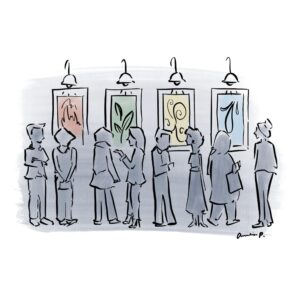From MPR News, Art Hounds are members of the Minnesota arts community who look beyond their own work to highlight what’s exciting in local art. Their recommendations are lightly edited from the audio heard in the player above.
Want to be an Art Hound? Submit here.
Walkin’ to New Orleans (and beyond)
Martha Bird is a Twin Cities visual artist who specializes in sculptural basketry. She admires Victoria Bradford Styrbicki’s show “Network: A River Connected,” which comprises a series of fishing nets and stories from the artist’s trip on foot down the Mississippi River.
The exhibit is open through Jan. 10 at the Mississippi Watershed Management Organization (MWMO) Stormwater Park and Learning Center in Northeast Minneapolis.
MPR News helps you turn down the noise and build shared understanding. Turn up your support for this public resource and keep trusted journalism accessible to all.
This Saturday, Styrbicki will hold a free net-making workshop. Register here. The artist will also be at the exhibit working on nets Monday, Nov. 4, and Dec. 16 between 10 a.m. and 3 p.m.
Martha says: In 2019, Victoria did a walk from the headwaters all the way down to coastal Louisiana, and she stopped at 104 different communities and talked to people in those communities and listened with compassion and grace to their stories about the river.
When you walk into the exhibit, what you notice right away is these very, very large nets. She has round nets. She has nets from floor to ceiling and then all across the ceiling. Then as you walk in, you see a map of where she stopped. She has quotes up from people that she talked to. She has a 14-minute video from people in the various communities, and the video starts with Minnesota’s Prairie Island indigenous community talking about water.
My takeaway from this exhibit is just how powerful art is when it comes out from deep within you. So not only has she lived along the Mississippi River, her ancestors are net makers, her current family members are net makers. They use them in fishing. People still use them. It’s a dying art.
And so the effort that she took to learn about the river, about the history, and to present this in a way that the public can enter in and learn as well is really, really powerful.
— Martha Bird
‘The Mikado’ moves to the Scottish Highlands
Doris Rubenstein is looking forward to seeing Gilbert & Sullivan’s opera “The McAdo,” which is “The Mikado” with a Scottish twist. The Gilbert & Sullivan Very Light Opera Company moves this performance from Japan to the Scottish Highlands.
Two casts of principals will alternate performances at the Conn Theater, located inside the Plymouth Congregational Church in Minneapolis. The show runs Friday, Nov. 1 through Nov. 24.
Doris says she’s seen “The Mikado,” multiple times, but: The whole concept of this “McAdo” is enough to pique my curiosity. They’ve taken the action from Japan, moved it to the Scottish Highlands, and renamed it.
The storyline has some resemblance to the original but many of the place names and character names have been given a Celtic twist. For example, Nanky-Poo is Lanky Doug, Yum Yum is Wynn Somme and Kata Sha is Katie Shaw.
Sir Arthur Sullivan’s music is the same, but W.S. Gilbert might be rolling in his grave to hear the parodies made from his lyrics to match the Scottish locations and to rhyme the new names given to the story’s characters.
— Doris Rubenstein
Synth and snyth again
Trombonist John Sievers of Rochester is looking forward the world premiere of a composition by Winona musician Eric Heukeshoven called the Re-Synth Project which is written for concert band and music technology.
The piece will be performed by two different bands as part of their concerts this weekend at the DuFresne Performing Arts Center at Winona State University. High School Honor Band Festival performs Saturday, Nov. 2 at 5 p.m. and WSU Wind Ensemble will be in concert Sunday, Nov. 3 at 2 p.m.
John says: I guess partially also what I’m really interested in is that some of the triggers are samples of traditional band instruments that have been pre-recorded.
So you’re hearing basically like members of the Winona State Wind Ensemble, having a duet with themselves in a previous version. But also, some of the samples are things like crowd noises or things like bird song that maybe aren’t traditional parts music that you would hear a counter band creating.
— John Sievers

Composer Eric Heukeshoven.
Courtesy photo
This post was originally published on this site be sure to check out more of their content



